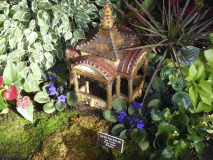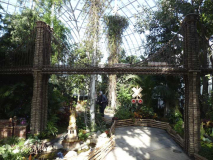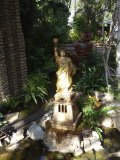Every Christmas (from November to January), there’s an incredible model train show held in the Haupt Conservatory at New York Botanical Garden in the Bronx that incorporates dozens of famous (and not as famous) NYC architectural highlights, constructed from twigs, leaves, bark, berries and other natural materials by Paul Busse and his team at Applied Imagination at Alexandria, Kentucky. The show takes months to prepare and build – work for next year’s show begins almost immediately after this year’s is dismantled!
I visited the Train Show in January 2016, when it was about to close and pack up for the season. I made an effort to photograph each and every scale model in the show. Though I was a scale model railroad buff as a kid, the fascination hasn’t carried on to middle age, and I respect the genre — but Forgotten Fans expecting me to rattle on about the merits of the miniature RR that NYBG uses here will be a bit disappointed. I can say that NYBG used G-scale, mainly used for outdoor shows; the G stands for the German word groß, “large.” For my indoor layouts as a kid, we used N-scale trains sold under the “Postage Stamp” brand, manufactured by scale model producer Aurora. I’m sure aficionados remember them. Anyway, we would periodically try to store our trains in the basement of our apartment house, and the neighborhood youth would reappropriate them for community use, putting an end to our own model train ambitions, but we’d always visit the truly impressive model train show held every year in a Bay Ridge basement; to my knowledge the Bay Ridge Model Railroad Club continued its annual exhibits up to 2013. If there is any further info, drop me a line at kevinjudewalsh@gmail.com.
I have reported about the Train Show in Forgotten New York before, but the exhibits change every year. Busse and his crew, though Kentucky-based, show an incredible amount of meticulous research in putting together the show every year. As we’ll see, the 2015-2016 show presented a some material in historical context, restoring in the exhibit building details that vanished long ago.
This year’s Train Show has opened its doors for the 2016-2017 season. Every year some of the scale models are swapped out for new material, so no two seasons are the same — if these FNY pages make your curious about the show, by all means attend this year, as you’ll see something not shown here.
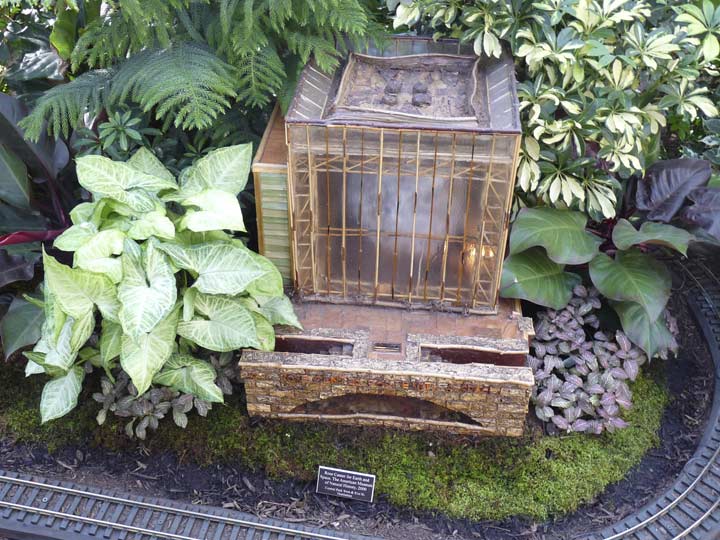
I hadn’t been to the Hayden Planetarium since I visited while with the Cub Scouts in the mid-1960s, and never will again–since the original building, opened in 1935, was demolished in 1997 to make way for the new Frederick Phineas and Sandra Priest Rose Center for Earth and Space (known as the Rose Center) which opened for business in 2000 on the north side of the Museum of Natural History plot on West 81st Street near Central Park West. It’s a must see for any out of towner, and some in-towners like me who have never been there! The director is the frequently-quoted Neil DeGrasse Tyson.

Who is buried at Grant’s Tomb?
The last resting place of the 18th President, Ulysses S. Grant, and his wife on Riverside Drive on the Upper West Side has been the subject of NYC’s most infamous, and silliest, riddle over the years. The correct answer is that nobody is buried under the monument…Grant and his wife are, however, entombed here and are not six feet under. (That’s why it’s Grant’s Tomb, not Grant’s Grave.)
Luna Park, Coney Island’s central tower, ticket booth, and entrance arch.
Luna Park was a wonderland unlike anything the world has seen before or since. It was the brainchild of Elmer “Skip” Dundy and Frederic Thompson [who] created a ride called “A Trip to the Moon” and exhibited it at the 1901 Pan-American International Exposition. George C. Tilyou saw the ride there and told the pair to bring their “Trip to the Moon” with them to Steeplechase Park. After the 1902 season Tilyou asked for a larger cut of the ride’s profits, which prompted Thompson and Dundy to consider buying their own park. They purchased Captain Paul Boyton’s Sea Lion Park, a “ramshackle cluster of attractions.” The pair tore everything but the Shoot-the-Chutes down as a new style of amusement park was built over the winter of 1902-1903.
On May 16, 1903 Luna Park opened at night. The legend has it that the duo had so little money they combed the beach for change for the ticket takers. As Albert Bigelow Paine said, “A long festoon of electric light leaped from one side of the park to the other, and was followed by a second and a third. Then there was a perfect maze of them. Tall towers that had grown dim suddenly broke forth in electric outlines and gay rosettes of color, as the living spark of light traveled hither and thither, until the place was transformed into an enchanted garden, of such Aladdin never dreamed.” In February, 1907 Elmer Dundy died and Thompson was set a adrift. Five years later he went bankrupt and the bank took Luna from Thompson. Although the park was fun after he left all of the creativity was gone. Luna, under the direction of investors and money men, operated until 1944. Fires that year caused the park to limp through the end of the season and it remained closed throughout 1945. The next year the park was closed and sold to a group that demolished it. An undignified end to a beautiful play land. —Amusement Park History website, now 404’d
Infamously, Luna Park was where, in 1903, Topsy the Elephant was electrocuted by Thomas Edison’s organization in an attempt to show that the rival to his direct current, alternating current, was dangerous.
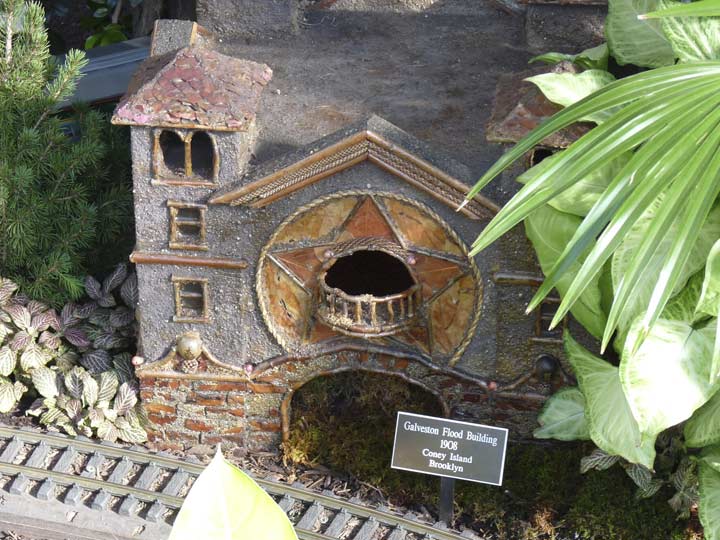
Galveston, Texas was pummeled by a devastating flood in September 1900 when a hurricane hit nearby, bringing 125 mile winds and a 15 foot storm surge; n estimated 12,000 people met their deaths.
In 1902, Coney Island responded by opening a cyclorama, or scale model, exhibit of the flood housed in this building at Surf Avenue and West 17th Street in which the flood was recreated.
There were also exhibits that re-created the 1889 Johnstown, PA flood and the 1906 San Francisco earthquake.
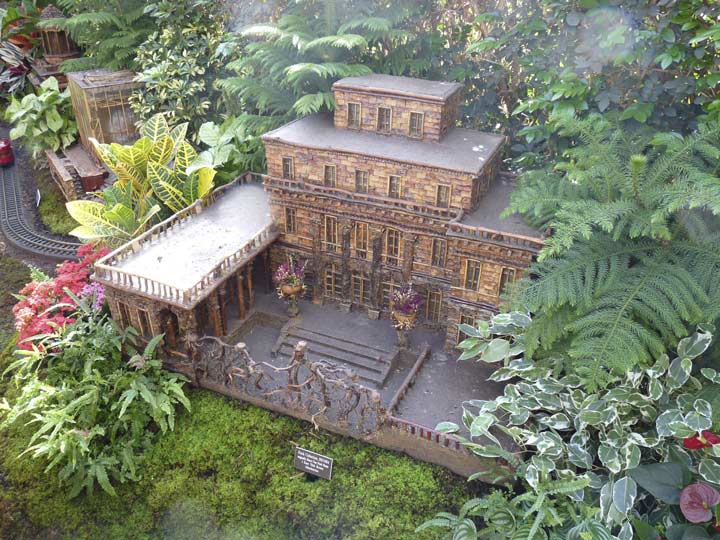
The Frick Collection is housed in industrialist/philanthropist Henry Clay Frick’s (1849–1919) massive townhouse on 5th Avenue between East 70th and 71st Streets. The Collection, opened in 1935, consists of sculptures, paintings and decorative art from the Middle Ages up to the late 19th Century. Even more of Frick’s treasure trove can be visited at his Pittsburgh residence, Clayton, and at the University of Pittsburgh.
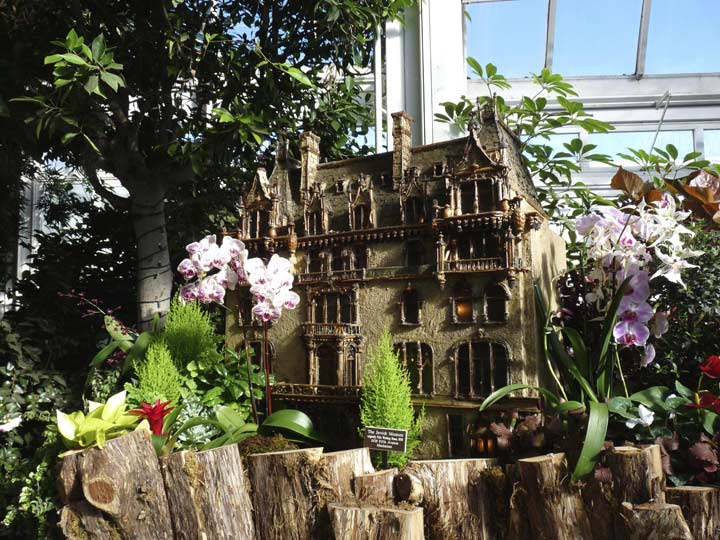
The Carnegie Hill/Yorkville area is a largely unplumbed one for me (it’s on the Lexington Avenue subway line, relatively harder to access from Penn Station, to where I take the Long Island Rail Road) and there are a number of older, or more spectacular buildings around. The Jewish Museum, 5th Avenue and East 92nd, is in a mansion built by C.P.H. Gilbert for philanthropists Felix and Frieda Warburg in 1908 at the height of the Beaux Arts era. Gilbert’s model was the chateaux of the Loire region of France.
Frieda Schiff Warburg donated the house as the permanent home for the museum in 1944. A 1993 adjacent addition deftly copied the 1908 original.
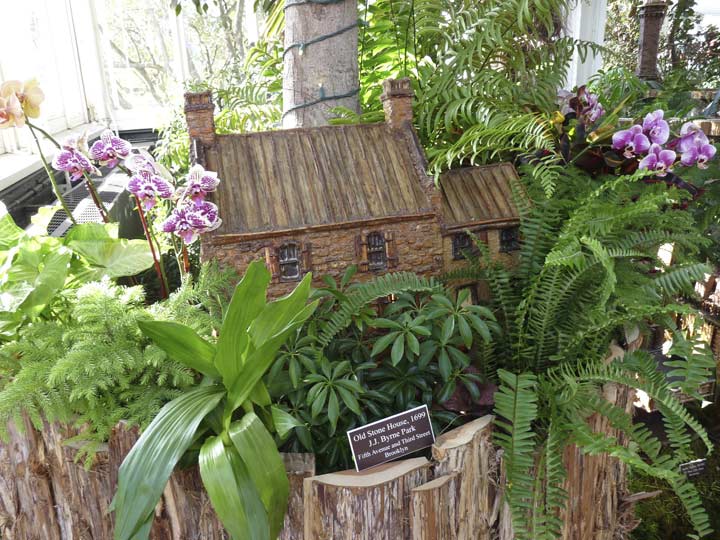
Another building from the NYBG collection from the colonial era is what we now call the Old Stone House was originally built in 1699 by Dutchman Klaes Arents Vecht. The house remained in the Vecht family until just prior to the American Revolution, when it was rented to an Isaac Cortelyou; his father, Jacques, bought the property in 1790. Officially known as the Vecht-Cortelyou House, the Old Stone House played a pivotal role in the American Revolution. On August 27, 1776, during the Battle of Brooklyn, things looked dire indeed for the Americans, as the British and Hessians were overwhelming them in what is now the northern section of Prospect Park.
Hoping to reach forts at Boerum Hill and Fort Greene, about 900 American troops retreated from what would be the Greenwood Cemetery area; they hoped to track northward. General William Alexander, also known as Lord Stirling, led a company of 400 Maryland troops (this is the Maryland state flag) that engaged British General Charles Cornwallis’ force of 2000 grenadiers and cannoneers at the Stone House to cover the retreat and, while many of the Americans were able to escape, Stirling was captured and 259 of the Maryland troops were killed. George Washington, observing the battle from what is now Cobble Hill, is said to have uttered: “What brave fellows I must this day lose.”
In 1850 the house was sold to developer Edwin Litchfield (who dredged the Gowanus Canal and built Litchfield Manor in Prospect Park). Litchfield proceeded to let the house fall into ruin and it was finally demolished in 1897. At the direction of Brooklyn Borough President J.J. Byrne in 1930, the house was reconstructed from remaining bricks and the original foundation and was completed in 1933. The surrounding park was named for Byrne.
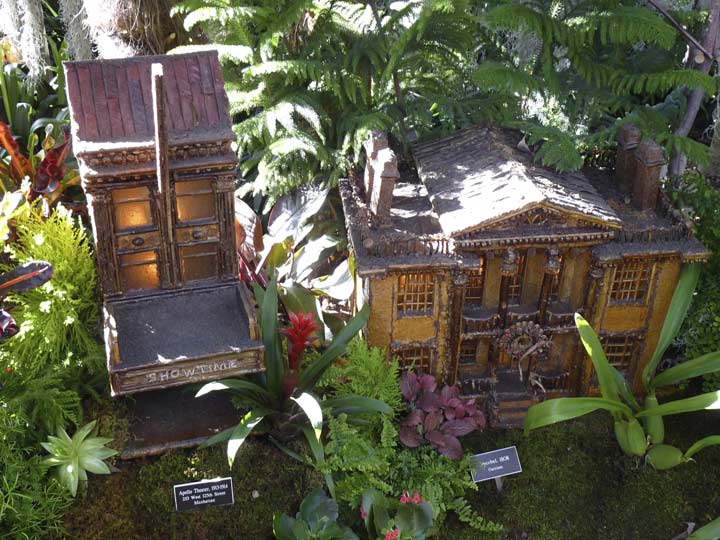
Left: The Apollo Theater, West 125th Street between Powell and Douglass Boulevards, opened in 1914 and has hosted its famed Amateur Night competitions since 1935; the Apollo helped launch the careers of Ella Fitzgerald and Jimi Hendrix, along with many others. The building has been considerably altered, but Busse and company depict it was it was in ints early years.
Right: NYBG also presented mansions and buildings outside NYC limits. Boscobel, in upstate Garrison by the Hudson River, is a mansion built by States Dyckman (of the same family associated with Dyckman Street and the Dyckman Farmhouse in Inwood) and completed after his death, in 1808. The name comes from two Italian words meaning “beautiful woods” and is also the name of an estate in Shropshire, England.
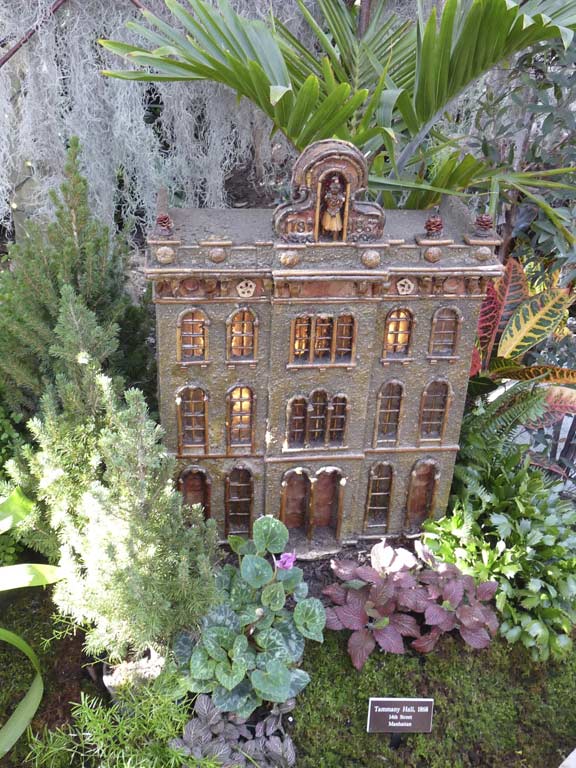
Tammany Hall was an organization associated with the Democratic Party that dominated NYC politics for about a century, from the 1830s through the 1930s. The name was a bowdlerization of the name of a (likely fictional) Indian chief.
Tammany Hall, also known as the Society of St. Tammany, the Sons of St. Tammany, or the Columbian Order, was a New York City political organization founded in 1786 and incorporated on May 12, 1789 as the Tammany Society.
It was the Democratic Party political machine that played a major role in controlling New York City and New York State politics and helping immigrants, most notably the Irish, rise up in American politics from the 1790s to the 1960s. It controlled Democratic Party nominations and political patronage in Manhattan from the mayoral victory of Fernando Wood in 1854 through the election of John P. O’Brien in 1932.
The original headquarters building for the Society, the first Tammany Hall, was built in 1830 in Manhattan at 141 East 14th Street between Third and Fourth Avenues, but the building was not primarily the clubhouse of a political organization. In 1927 the building on 14th Street was sold, to make way for the new tower being added to the Consolidated Edison Company Building. wikipedia
To be sure the Train Show features such icons as the Brooklyn Bridge (1870-1883) and Statue of Liberty (1880-1886) that are hardly Forgotten. I made an effort to photograph everything in the 2015 exhibit.
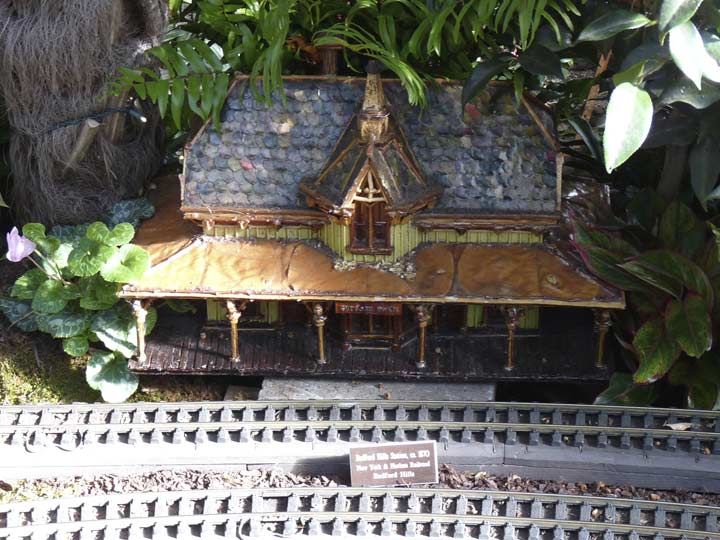
The original Bedford Hills railroad station building in the upstate suburban location served by the Metro North RR, constructed by the NY Central RR in 1870, still stands beside the platform, but is now used for commercial purposes.
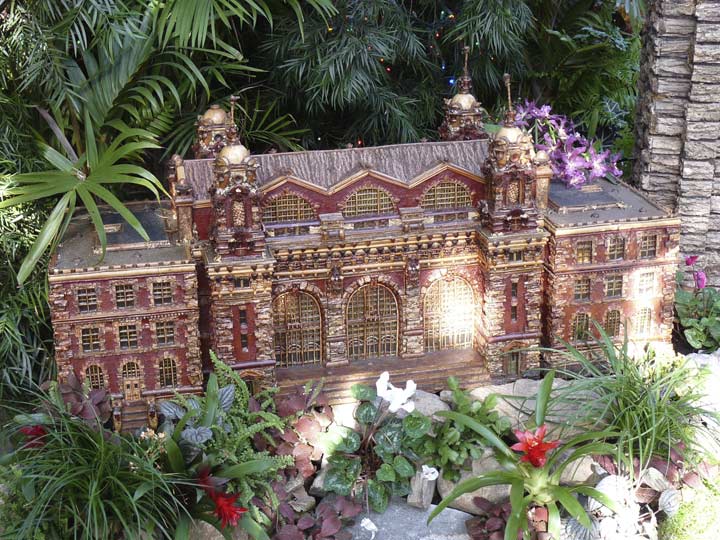
Ellis Island Main receiving Station: The present main structure was designed in French Renaissance Revival style and built of red brick with limestone trim. After it opened on December 17, 1900, the facilities proved to be able to barely handle the flood of immigrants that arrived in the years before World War I. Writer Louis Adamic came to America from Slovenia in southeastern Europe in 1913 and described the night he and many other immigrants slept on bunk beds in a huge hall. Lacking a warm blanket, the young man “shivered, sleepless, all night, listening to snores” and dreams “in perhaps a dozen different languages”. The facility was so large that the dining room could seat 1,000 people. It is reported that the island’s first immigrant to be processed through was a teenager named Annie Moore from County Cork in Ireland. wikipedia
Ellis Island was named for merchant Samuel Ellis, who owned it in the colonial era; before his ownership it was called Oyster Island. The island has been owned by the Federal Government since 1808 and after 1954, when the immigrant receiving station was closed, operated by the National Parks Service.
Though portions of the main building have been restored and are open to the public, much of the island is still in ruin. Hurricane Sandy did major damage in 2012, but repairs were effected and the public area reopened in 2013.
In 2008, I attended the premier of Lorie Conway’s documentary, Forgotten Ellis Island, and met actor Elliott Gould, who narrated.

In 1803 the cornerstone was laid for the current New York City Hall, which was designed by Joseph Mangin and John McComb. When the building opened in 1812 many felt that it was too far north of the center of the City and this the “rear” of City Hall was constructed with cheaper materials!
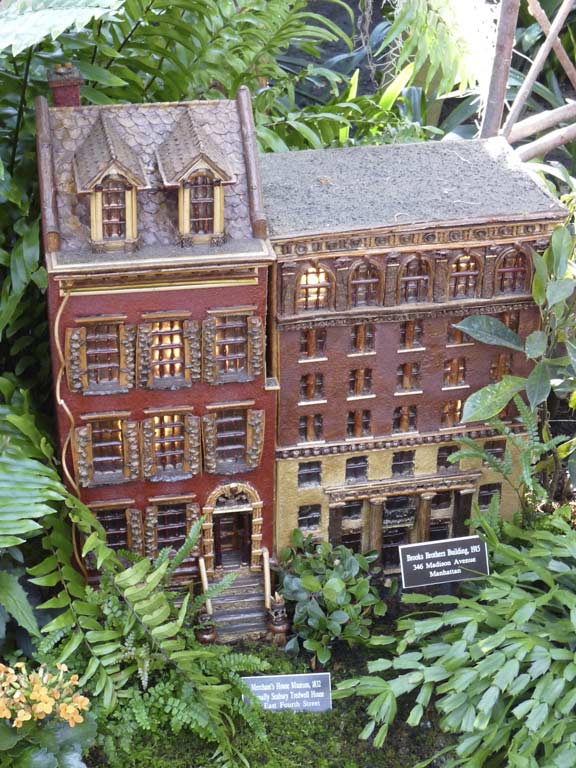
Believe it or not I’ve never been inside the Federal/Greek Revival Seabury Tredwell House (left) at #29 East 4th, built in 1832 for Joseph Brewster but later owned by merchant Seabury Tredwell, who left it to his spinster daughter Gertrude, who resided here until her death in 1933; she was the inspiration for Henry James’ “Washington Square” and its film adaptation, The Heiress. Inside furnishings have been kept pretty much as they were in Gertrude’s day as the Merchant’s House Museum, and some say Gert hasn’t left yet and the house is haunted. (I would love the chance to disprove this by staying there overnight.)
The Brooks Brothers flagship store is at 346 Madison Avenue and East 44th Street. The haberdasher, founded in 1818 by Henry Sands Brooks (1772-1833) and after his four sons, Elisha, Daniel, Edward, and John, inherited the business upon their father’s death, renamed it “Brooks Brothers” in 1850. The company’s first store was located at Catherine and Cherry Streets on the Lower East Side and occupied four other downtown locations before constructing this Federally-inspired building as the flagship location in 1915.
While Brooks Brothers was outfitted 39 Presidents and is considered a somewhat conservative institution, 346 Madison has had its quirks. There was once a dude ranch managed from the 4th floor, and there was actually once a Brooks Brothers tobacco brand. Jackets were once displayed on tables inside out until, in 1966, Prince Philip complained that that arrangement looked sloppy, and onto hangers they went.

Mary Mason Jones mansion, #1 East 57th Street at 5th Avenue, was a French-style country palace built for the rich widow Jones in 1869 and the building survived there until 1928.
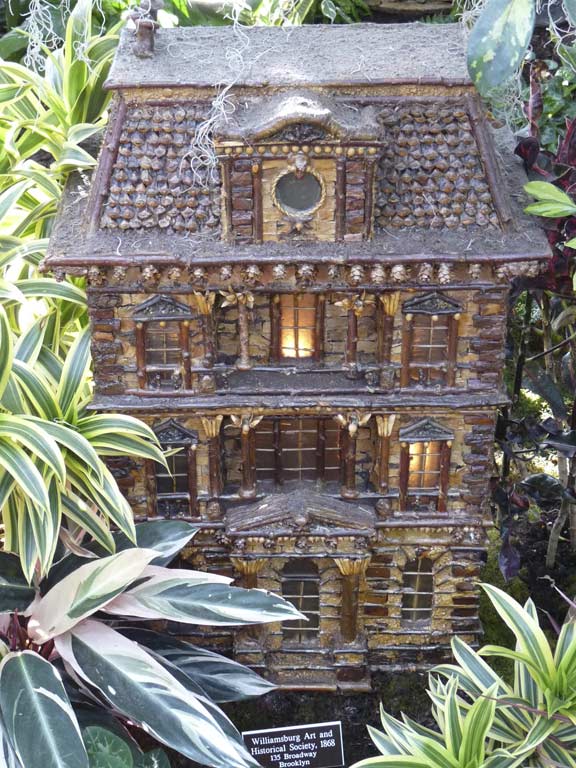
The former Kings County Savings Bank built in 1868 at Broadway and Bedford Avenue has become one of the focal points for Williamsburg’s burgeoning art community, but it’s a uniquely handsome structure in its own right. Architectural critic Francis Morrone has called it “probably the finest Second-Empire-style building in Brooklyn.” Second-Empire architecture, so called because it arose during the “second empire” of Louis Napoleon in France, featured sloped mansard roofs, the better to admit light onto the grand boulevards being built in the city by Baron Georges-Eugene Haussmann in the 1850s and 1860s; mansard roofs had been invented in the 17th Century by François Mansart. The Art and Historical Center features amazing detail such as carven beehives on its pediment.

The St. Nicholas Greek Orthodox Church at 155 Cedar Street downtown, originally built in 1832, was destroyed by falling debris from the World Trade Center during the terrorist attack on 9/11/01. Its replacement, the St. Nicholas National Shrine, is under construction nearby on the WTC site.

The Fuller, or Flatiron, Building was completed in 1902 in the wedge-shaped plot formed by 5th Avenue and Broadway as they cross at 23rd Street. It was named for the castiron clothing presser in use before the era of electric irons. It was designed by Chicago architect Daniel Burnham in a vertical renaissance palazzo style. The original tenant, George Fuller, headed a construction business. The Flatiron was declared a NYC landmark in 1966.
The Folies Bergere Theatre, 210 West 46th Street in the Theatre District, opened in 1911 and was named for the famed Parisian theater, but was renamed the Fulton just a few months after it opened. The Fulton was renamed for actress Helen Hayes in 1955, but it was demolished in 1982 to make way for the Marriott Marquis Hotel. The theater helped launch the careers of Mae West and Audrey Hepburn.
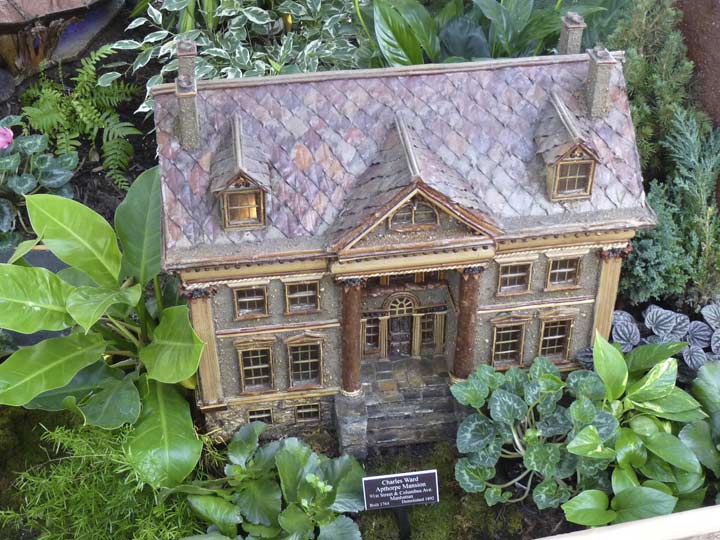
The Charles Ward Apthorpe Mansion was at what became Columbus Avenue and West 91st Street. When constructed in 1794, the Bloomingdale Road was the only major north-south road in the area and it was connected to the mansion by a driveway. Apthorpe was a major uptown landholder in the pre-Revolutionary War era.
Ward laid out a minor street grid on his property that included streets called Striker’s Lane and Jauncey’s Lane, but these lanes have by now completely vanished.
Though the Mansion deteriorated over time and was finally razed, the Apthorp(e) name is remembered in the grand Renaissance Revival Apthorp Apartments that fill the block between Broadway, West End Avenue, West 78th and West 79th Street. The apartment building was completed in 1908. It was constructed on the site of a first building constructed by Charles Ward Apthorpe in 1759.

The neo-Georgian style Willard Straight House at 1130 5th Avenue and East 94th Street was completed in 1915. I visited the building once in the late 1990s when the International Center of Photography was located there (the ICP is currently located in the New Museum at 250 Bowery).

Lighthouse Park, at the northern end of Roosevelt Island, is named for the lighthouse built by architect James Renwick Jr., who also built the island’s Smallpox Hospital, in 1872. It replaced a small fort built by Thomas Maxey, a patient in the nearby “Octagon” lunatic asylum (that deteriorated almost completely but has been rebuilt as luxury housing).
A plaque carved by another patient, John McCarthy, who claimed to have assisted in its construction, is reported to have been here until the 1960s, when it was stolen. It read:
This is the work
Was done by
John McCarthy
Who built the light
House from the bottom to the
Top all ye who do pass by may
Pray for his soul when he dies
(nice enjambment there)
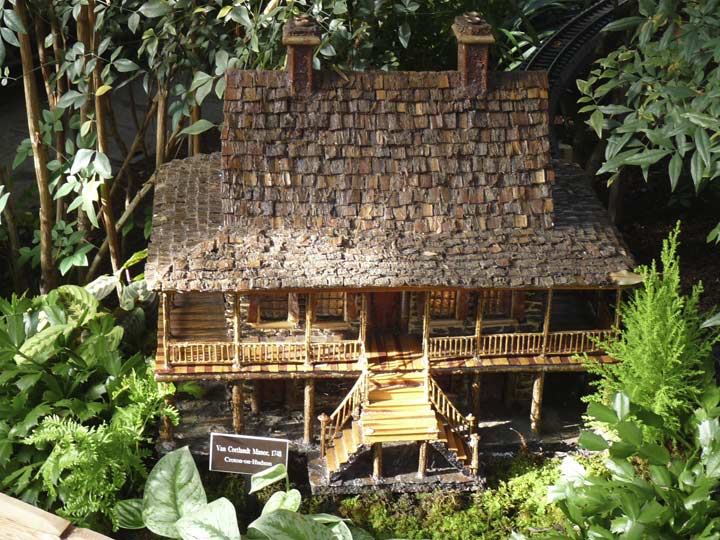
This isn’t the familiar Van Cortlandt Manor I know from my many visits to Van Cortlandt Park in the Bronx, but rather another manor in upstate Croton-on-Hudson, NY. It was constructed by Stephanus Van Cortlandt, who was a member of the same Van Cortlandt family that built the mansion I’m familiar with. The Croton manor was built around 1730.
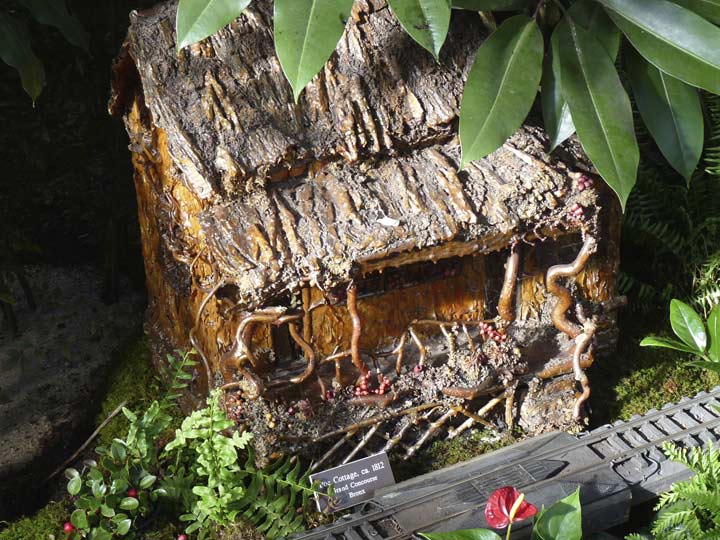
Poe Cottage was a small hovel on Kingsbridge Road in the Bronx occupied by author Edgar Allan Poe, his wife Virginia and her mother. It was moved to Poe Park in the early 20th Century. The Train Show depicts it, in an educated guess, as it must have appeared in 1812 when it was constructed.
When Poe was here between 1846 and 1849, there was no Concourse, and Bronx was not yet a part of New York City. In fact the house stood far out in the country. That’s what Poe was looking for, believing the clear country air would invigorate the ailing Virginia, who had tuberculosis. Tragically, it did not work and Virginia died; one of his best-known poems, “Annabel Lee”, is thought to memorialize her.
Poe and his family were destitute while living in the little farmhouse. He was a literary success but had lost his savings in a failed magazine venture. The author and his mother-in-law had to forage in nearby fields for the family’s sustenance.
The cottage itself was built in 1812 by farmer John Wheeler and stood on Kingsbridge Road until it was moved to its present location in 1913. It is one of four Poe museums in the USA; it is sparsely funished in the fashion Poe must have had it while here, with a cast-iron desk, rocking chair, mirror and straw bed. It is thought that the bed, gold-framed mirror and rocking chair belonged to Poe himself. Tours of Poe Cottage can be arranged with the Bronx Historical Society at (718) 881-8900.

Staten Island’s longest street, Hylan Boulevard, begins and ends with 17th Century houses: “Clear Comfort,” which for many years was home to Alice Austen, features an original section dating to as far back as 1691, while the Conference, or Billopp, House in Tottenville at the other end of Hylan, was built in 1680.
Alice Austen (1866-1952) was born to a prosperous family in what was then a part of Clifton and is now Rosebank. Her father, Edward Munn, disappeared before her birth; her mother, Alice Cornell Austen, moved with her daughter to her parents’ house, Clear Comfort, shortly after that. The house, at 2 Hylan Blvd. (then 2 Pennsylvania Avenue) had been purchased and later completely renovated from a simple farmhouse to a Victorian cottage by John Haggerty Austen, Miss Austen’s grandfather, in 1844.
Miss Austen was introduced to photography by her uncle, Oswald Müller, in 1876, when she was ten. Aside from Müller’s original demonstrations, her photographic skills and techniques were entirely self-taught, she insisted. Her subjects ranged from her family and friends on Staten Island to Manhattan’s newsboys and newsgirls, pushcart vendors, bootblacks, organ grinders, and rag pickers, subjects you would not expect a woman of privilege to entertain.
Unlike the great women photographers who followed her in the 20th Century such as Berenice Abbott, Margaret Bourke-White, or Diane Arbus, Miss Austen never thought about selling any of her work. She never had to, since her family was wealthy and prominent. As the decades rolled on Miss Austen and her companion, Gertrude Tate, became the sole residents at Clear Comfort and settled into a comfortable life of dinner parties and gatherings; but the 1929 stock market crash relieved her of her life savings at age 63 after she had speculated unwisely on land out west. By 1945 the women were forced to sell their possessions and move out of the house that had been home to Miss Austen’s family for over 100 years.
When she was forced to move from Clear Comfort in 1945, Miss Austen called on an old friend, Loring McMillen of the Staten Island Historical Society, for assistance. McMillen was able to rescue some cardboard boxes in the basement containing 3,500 glass plate negatives: these comprise the collection of Miss Austen’s photographs we have today. A young writer, Oliver Jensen, published several of Miss Austen’s pictures in Life and Holiday in 1951, and the proceeds from the sale allowed her to move into a more comfortable nursing home, where she remained until her death in 1952. In October 1951 she had attended an exhibition of her life’s work at Historic Richmond Town.
In 1985 Clear Comfort was refurbished, to the way it appeared in Miss Austen’s day, as a museum.
That will wrap it up for this week, but I have more for the next week or two as I strove to photograph every building presented in the Train Show.
11/27/16



